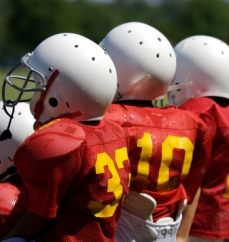Young athletes in the U.S. face a "culture of resistance" to reporting when they might have a concussion and to complying with treatment plans, which could endanger their well-being, says a new report from the Institute of Medicine and National Research Council.[1]
'Insidious influence' of culture
The report emphasizes the overarching role the culture of contact and collision sports plays in the current recognition and management of concussions in young athletes, a culture that, in many settings, causes the seriousness of the threat to the health of an athlete, both acute and long term, from suffering a concussion to be downplayed or not acted upon.
"Too many times the committee read or heard first person accounts of young athletes being encouraged by coaches or peers to 'play through it.' This attitude," says the report, "is an insidious influence that can cause athletes to feel that they should jeopardize their own individual health as a sign of commitment to their teams. Despite increased knowledge about concussions and a growing recognition in
recent years that concussions involve some level of injury to the brain and therefore need to be diagnosed promptly and managed appropriately, there is still a culture among athletes and military personnel that resists both the self-reporting of concussions and
compliance with appropriate concussion management plans."
"If the youth sports community can adopt the belief that concussions are serious injuries and institute behaviors and adopt attitudes that emphasize care for players with concussions until they are fully recovered, then the 'culture' in which young athletes perform and compete will become much safer," says the report.
Helmets do not reduce concussion risk
Consistent with a large body of evidence, the committee found little
evidence that current sports helmet designs reduce the risk of
concussions. It stressed that properly fitted helmets,
face masks, and mouth guards should still be used, because they reduce
the risk of other injuries -- such as skull fractures; bleeding inside
the skull; and injuries to the eyes, face, and mouth. The marketing for
some protective devices designed for youth athletes, such as mouth guards
and headbands for soccer, has advertised that these devices reduce
concussion risk, but there is a lack of scientific evidence to support
such claims, the committee said.

Cognitive rest: jury still out
The committee recommended an individualized treatment plan for concussion that includes physical and mental rest, but said current research does not indicate a standard or universal level and duration of rest needed. Athletes who return to play before their brain has fully healed may place themselves at increased risk for prolonged recovery or more serious consequences if they sustain a second brain injury, the report said.
Identification hampered by lack of trained personnel
The assessment of an injured player is facilitated by the presence of a certified athletic trainer, team physician, or other health care provider at the venue (e.g., field, gymnasium, or rink) where the injury occurred, says the report.
Unfortunately, the vast majority of young athletes practice and play in circumstances where trained personnel are not routinely available to make sideline injury assessments, and the responsibility for determining whether to remove an athlete from play falls on coaches, parents, players, and, perhaps, officials, who often lack the training necessary to perform such assessments.
Use of multiple sideline screening tools recommended
The committee endorsed the current preferred method of using multiple evaluation tools, such as symptom scales and checklists, balance testing, and neurocognitive assessments, in making remove-from-play assessments on the sports sideline, and diagnosing concussions, which it said, may increase the sensitivity and specificity of concussion identification, although it noted that existing evidence is insufficient to determine the best combination of measures.
Neurocognitive testing: not diagnostic standing alone
Although the committee recognized neuropsychological testing "as a powerful tool for understanding the cognitive effects of brain injury," it noted that it "has inherent limitations" and the existence of numerous factors that affect the resulting scores and interpretations.
The report says that there is "general agreement that neuropsychological tests should not be used in isolation for diagnosis" and that symptom levels are the "best predictor of diagnosis." Although the presence of symptoms can influence test results, the committee said, "potentially obscuring the accurate measurement of brain function, neuropsychological testing is one of several tools (along with symptom assessment, clinical evaluation, and the like) that may aid in concussion diagnosis."








